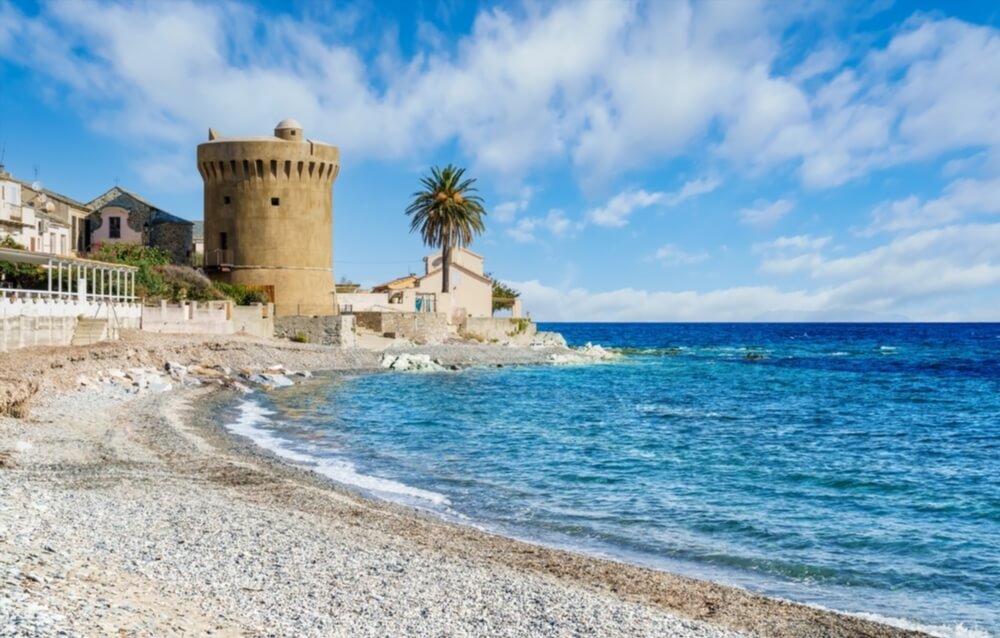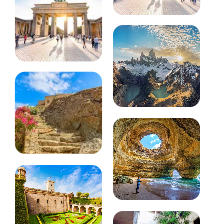The most beautiful villages in Corsica around Bastia

Northern Corsica is packed with picturesque villages that seem to defy time. Nestling between turquoise seas and verdant mountains, these authentic gems offer incomparable charm to travellers in search of authenticity. Bastia, the gateway to the Île de Beauté, is the ideal starting point for discovering the architectural and cultural wonders for which the region is famous.
1. Erbalunga, the fishing village par excellence
Download the audio tour to discover Bastia on foot and on your own
Before setting off to discover the surrounding villages, let yourself be guided around Bastia on the Navaway audio tour. In just 1? hours, this 3.5km walk will reveal the 23 places of interest in the pearl of the Isle of Beauty, from the citadel to the Old Port, via Place Saint-Nicolas and Sainte-Marie Cathedral.
Just 10 kilometres north of Bastia, Erbalunga stands like a living postcard on the eastern coast of Cap Corse. This authentic fishing village, listed as one of the most beautiful in France, has a well-preserved character and typical Genoese architecture.
The houses with their pastel-coloured facades are reflected in the calm waters of the little port, creating a picture of striking beauty. The Genoese tower, built in 1488 and rebuilt after the destruction of 1553, still stands guard over this haven of peace. Its ruins, listed as a Historic Monument, bear precious witness to the turbulent history of Corsica.
The village has long attracted artists, earning the nickname “artists’ nest” in the 1930s. This bohemian atmosphere lives on to this day, with art galleries and craft workshops dotting the narrow streets.
2. Nonza, the village suspended from the cliffs
Perched on a vertiginous 160-metre cliff, Nonza offers one of the most spectacular panoramas in Corsica. This medieval village, probably one of the oldest on the island, fascinates visitors with its exceptional location and remarkable architectural heritage.
The Paoline tower, built in 1760 on the orders of Pascal Paoli, majestically dominates the village and the sea. Unlike the other Genoese towers, this square fortification bears witness to the period of Corsican independence. On a clear day, you can see all the way to the Tuscan archipelago from the summit.
Below, the black pebble beach contrasts strikingly with the turquoise waters of the Mediterranean. This particular colour comes from former asbestos mines, creating a unique landscape. The village’s cobbled streets wind between the shale houses, leading to the baroque church of Sainte-Julie, dedicated to the patron saint of Corsica.
3. Centuri, lobster kingdom
Centuri, on the west coast of Cap Corse, is a charming little town with a well-preserved authenticity and a traditional fishing industry. This small natural harbour, recognised as France’s leading lobster fishing port, perpetuates an ancestral know-how.
The brightly-coloured fishermen’s houses harmoniously frame the harbour, creating an idyllic setting for savouring the local specialities. The village’s restaurants serve freshly caught lobster in a friendly atmosphere overlooking the sea.
Centuri’s history dates back to the 17th century, when it was Corsica’s second busiest fishing port after Erbalunga. In 1757, Pascal Paoli even made it the military port of the independent Corsican nation, testifying to its strategic importance.
Hiking trails allow you to explore the wild surroundings, between fragrant scrubland and secret coves, offering exceptional views of the jagged coastline of Cap Corse.
4. Patrimonio, land of winegrowers
Nestling in an exceptional natural amphitheatre, Patrimonio is a harmonious blend of architectural heritage and wine-growing tradition. This hilltop village overlooks the Gulf of Saint-Florent, offering breathtaking panoramic views of the sea and surrounding mountains.
The village is famous for its Patrimonio appellation, the first AOC in Corsica, which was awarded in 1968. The vineyards stretch across the limestone hillsides, producing wines of character in an enchanting setting. The wine route takes you to around thirty estates, each revealing the secrets of this unique terroir.
San Martin church, built in the 12th century, bears witness to the village’s rich historical past. Its Pisan Romanesque architecture and medieval frescoes are an exceptional part of the village’s heritage. The cobbled streets wind between traditional houses, leading to spectacular views of the Conca d’Oro.
The village has occupied a strategic position since Roman times, as evidenced by the archaeological remains discovered in the surrounding area. The statue-menhir found near the village bears witness to very ancient human occupation, dating back to the Neolithic period.
5. Pino, the balcony overlooking the sea
Dominating the western coast of Cap Corse, Pino is terraced on the steep mountain slopes. This perched village offers exceptional panoramic views of the sea and the islands of the Tuscan archipelago, particularly striking at sunset.
Traditional Corsican architecture flourishes in the narrow streets, where houses of green shale are adorned with colourful shutters. The Baroque church of San Quilico, with its slender bell tower, is a landmark visible from afar and a testament to Corsican religious art.
The Franciscan convent of Sainte-Lucie, located on the pass of the same name, offers a spiritual stopover in an unspoilt natural setting. This 16th-century chapel, perched at an altitude of 400 metres, marks the boundary between the eastern and western slopes of Cap Corse.
Hiking trails allow you to explore the wild surroundings, between fragrant scrubland and centuries-old chestnut groves. The customs path offers spectacular views of the jagged coastline and the Genoese towers that dot the coastline.
6. Santa Maria di Lota, the village on the balcony
Overlooking the bay of Miomo, Santa Maria di Lota is one of the famous “balcony villages” that characterise the area around Bastia. This charming residential village, nestling in the hills a few kilometres from the town, offers a privileged living environment between the sea and the mountains.
The church of Santa Maria Assunta, dedicated to the Virgin Mary, is the spiritual heart of the village. Its Baroque architecture and works of sacred art bear witness to the religious fervour of the local population. The church of Santa Antonio completes this remarkable religious heritage.
The 19th-century middle-class villas, testimony to past prosperity, are harmoniously arranged on the verdant slopes. Their terraced gardens, adorned with palm and olive trees, create a Mediterranean landscape of great beauty.
Its proximity to Bastia means that you can enjoy the benefits of city life while still benefiting from the tranquillity of an authentic village. The panoramic views over the sea and mountains of Cap Corse are a daily spectacle for locals and visitors alike.
7. The villages of the Conca d’Oro
The Conca d’Oro region, the “golden conch” that surrounds the Gulf of Saint-Florent, is home to a number of picturesque villages well worth a visit. Oletta, perched on its hill, offers spectacular views over the gulf and is an ideal starting point for exploring the region.
These typical villages have preserved traditional Corsican architecture, with their slate houses with lauze roofs and cobbled streets. The richly decorated Baroque churches bear witness to local religious art and the devotion of the local people.
Local craftsmen perpetuate ancestral traditions, with workshops for potters, blacksmiths and woodcarvers. The weekly markets offer the chance to discover local produce: Corsican cheeses, charcuterie, maquis honey and olive oil.
The local gastronomy reveals all the richness of the Corsican terroir, with specialities such as brocciu, canistrelli and Patrimonio wines. Family-run restaurants perpetuate traditional recipes in a typically friendly Corsican atmosphere.
An exceptional architectural heritage
The Corsican villages around Bastia are characterised by their unique architecture, a blend of Genoese, Pisan and local influences. The traditional houses, built of local schist, adapt harmoniously to the mountainous terrain and Mediterranean climate.
The Genoese towers, veritable stone sentinels, dot the coastline and bear witness to the defensive organisation put in place by the Republic of Genoa. These buildings, often in ruins today, are landmarks in the landscape and offer exceptional panoramic views.
Corsican religious art flourished in the Baroque churches, richly decorated with frescoes, gilded altarpieces and polychrome statues. These buildings, often disproportionate to the size of the villages, bear witness to the religious fervour of the population.
Fountains, wash-houses and communal bread ovens reveal the traditional social organisation of these rural communities. These heritage features, many of which have been restored, provide an insight into everyday life in days gone by.
A preserved and generous natural environment
The exceptional natural setting of these villages is one of their main attractions. Between the sea and the mountains, Corsica’s natural beauty unfolds in an enchanting palette of colours and scents.
The maquis, a plant formation emblematic of Corsica, perfumes the surrounding area with its aromatic essences: myrtle, arbutus, lentisque and immortelle. This dense, fragrant vegetation provides a natural backdrop for the villages and is home to a diverse fauna.
The chestnut groves, once a source of prosperity for the local people, now offer shady walks and bucolic landscapes. Hiking trails allow you to explore these ancestral forests and discover spectacular viewpoints.
The jagged coastline alternates between towering cliffs and intimate coves, offering breathtaking panoramas. The pebbled or fine sand beaches invite you to relax and enjoy water sports in an unspoilt setting.
In conclusion, the Corsican villages around Bastia are an exceptionally rich heritage, bearing witness to the island’s eventful history and the Mediterranean art of living. Each village reveals its unique personality, a blend of tradition and modernity, in a natural setting of striking beauty. To explore this fascinating region in greater depth, why not take theBastia audio tour, which will reveal all the secrets of this pearl of the Isle of Beauty.
What’s the most beautiful village near Bastia?
Erbalunga is often considered to be the most beautiful village around Bastia. This authentic fishing village, with its Genoese tower and colourful houses reflected in the harbour, offers an exceptional setting just 10 kilometres from the city.
How do I get to the villages around Bastia?
The car remains the most practical way of visiting the Corsican villages around Bastia. Erbalunga, Nonza, Centuri and Pino are all easily accessible from the roads of Cap Corse. For the villages on the balconies, such as Santa Maria di Lota, allow around 20 minutes’ drive from Bastia.
What’s the best time of year to visit these villages?
Spring (April-May) and autumn (September-October) offer the best conditions for discovering these villages. The temperatures are pleasant, the light exceptional and the number of tourists more moderate, allowing you to take full advantage of the authenticity of the area.
200 audioguided tours for cities all around the world
Download
